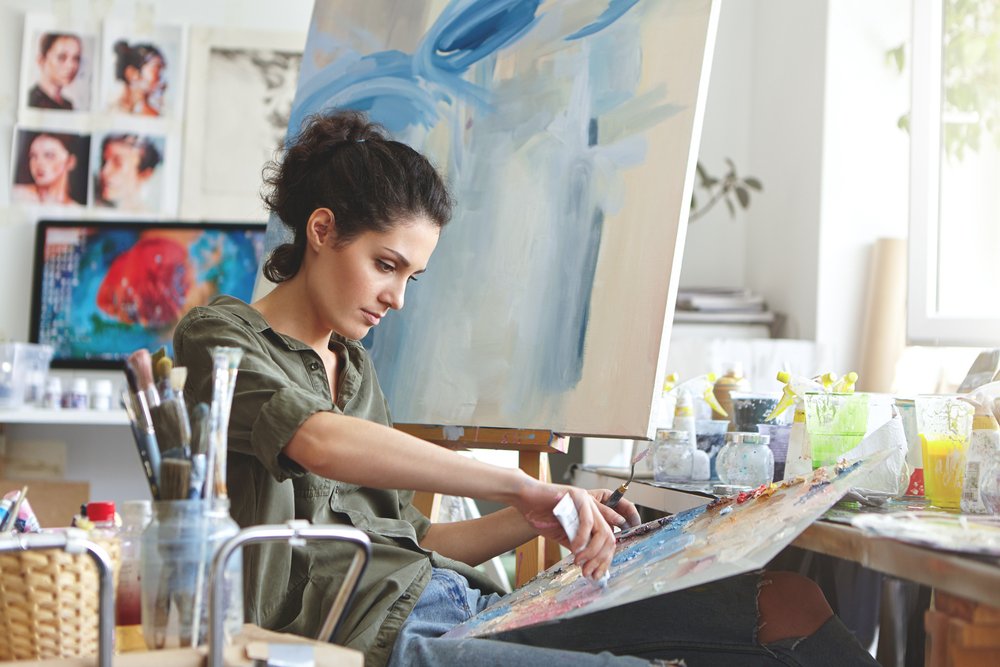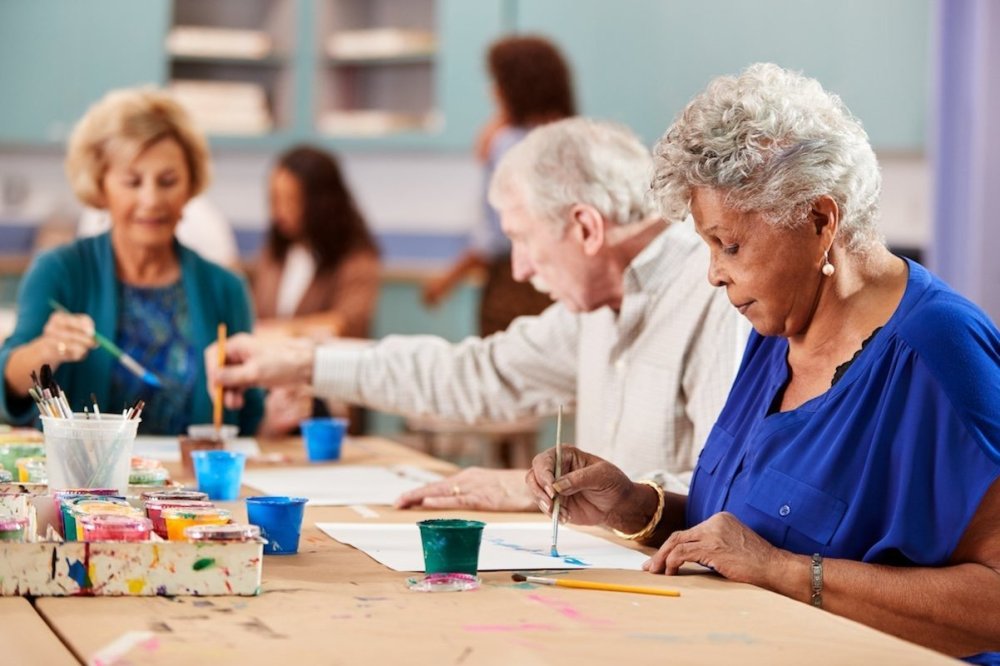Finding your flow, stress reduction and self-expression three ways in which practising art can help fight mental health issues. Stanislava Puač Jovanović explores the evidence around art therapy for depression and outlines the benefits it can bring to your mental health.
Art in any form presents a symbolic expression of the artist’s inner world. It is a vessel for self-exploration, articulation of subconscious contents, growth, and – psychological recovery. People have always felt this connection between creating or consuming art and the process of internal healing. Many great painters, sculptors, musicians and writers lived a life in which art was intertwined with mental health issues.
However, you do not have to be a painter or a musician to let art heal you. My father, God rest his soul, albeit not an artist by profession, survived the most challenging times in his (our) life by painting and listening to Led Zeppelin every night for many months.
In fact, using art for depression therapy and treatment has a long history. I'll review the empirical evidence corroborating art therapy’s potential to help people deal with depression. There are many options to use art for depression. I hope you will find your personal path towards soothing the darkness of depression through creating or enjoying artwork.
Art therapy for depression
You do not need to be a professional artist – not even slightly talented – to benefit from art therapy for depression. That's because the essence of its curative effect is not in the artistic quality of your creation – it's in exploring and expressing your most intimate experiences, often hidden from yourself, even. To bring this a little closer, I'll start with a quote from C. G. Jung, artistic in itself:
“I should advise you to put it all down as beautifully and as carefully as you can — in some beautifully bound book. It will seem as if you were making the visions banal — but then you need to do that — then you are freed from the power of them. If you do that with these eyes, for instance, they will cease to draw you. You should never try to make the visions come again. Think of it in your imagination and try to paint it. Then when these things are in some precious book, you can go to the book and turn over the pages, and for you, it will be your church — your cathedral — the silent places of your spirit where you will find renewal. If anyone tells you that it is morbid or neurotic and you listen to them — then you will lose your soul — for in that book is your soul.”
― C.G. Jung, Visions: Notes of the Seminar Given 1930-1934

Art can be a therapy for depression shutterstock/WAYHOME studio
Jung himself can be considered one of the most dedicated explores of one’s own psyche. Much of this self-exploration occurred in an interplay with art and its ability to make the symbolic nature of subconsciousness accessible. After having separated from Freud, during the nights in which psychosis menaced him, he kept on pursuing the inner images. During four years, Jung conducted these psychological experiments on himself and created Liber Novus (The Red Book). According to his own words, this self-work was by far the most important one in his professional and personal life.
The importance of self-expression and self-discovery
I allowed myself to speak about Jung to this extent because it is a wonderful illustration of what art can do for someone’s mental health. Art, being non-verbal and symbolic, opens up the path towards those parts of the psyche that cannot be expressed verbally without losing meaning. Art for depression, to emphasize Jung’s words again, serves to deliver “the silent places of your spirit where you will find renewal”.
RELATED: Feeling blue or clinically depressed? The 4 things you should look out for
Depression, as anyone who has experienced it to any degree knows, is a state in which destructive forces take over. When you engage in creating art, you are, in a way, presenting a counter-weight to such damaging energies within you. Creation fights the destruction. And you do it without struggling to convey, using words alone, the abyss inside you to someone else.
The evidence for art therapy
The American Psychological Association defines art therapy simply as: “the use of artistic activities, such as painting and clay modelling, in psychotherapy and rehabilitation. Art therapy provides the opportunity to express oneself imaginatively, authentically and spontaneously. Results of such a therapeutic work with art are personal fulfilment, emotional reparation and transformation.
Art therapy uses dance, drama, music, poetry and visual arts to help clients express themselves. It is based on an underlying notion of a holistic approach to people. In other words, we are as non-verbal beings as we are verbal – the former being potentially even stronger than the latter.
“Art, being non-verbal and symbolic, opens up the path towards those parts of the psyche that cannot be expressed verbally without losing meaning.”
Although using art for depression has a long history, starting from the 1940s, there are few controlled clinical art therapy trials. The reasons are methodological. Given the individualistic and uncontrolled, spontaneous flow of the therapeutic session, it is challenging to reach standardised conditions for trials to be conducted. However, the findings that are reported testify of the potent power of art for those struggling with depressive moods.
A 2007 study from Florida State University carried out on a group of convicts confirmed that those involved in an eight-week-long art therapy treatment experienced a significant decrease in symptoms of depression. Convicts have a strong urge not to express their problems verbally because a verbal disclosure might put them in more trouble. Therefore, the non-verbal nature of art for depression served as the ideal channel for dealing with it.
Meanwhile, a 2012 study out of Seoul Women's University conducted on older adults revealed that using art therapy to target depression could reduce negative emotions, improve self-esteem and decrease anxiety. The effects were highly evident, with a reported reduction of negative feelings of over 85 per cent. Another study with the elderly also supported such claims. Symptoms of depression reduced dramatically after just six weeks of art therapy.
 You don't need to be a skilled artist to try art therapy
You don't need to be a skilled artist to try art therapy
Among women who were recently diagnosed with breast cancer, according to findings, creative arts therapy intervention brought about an increase in self-expression, spirituality and psychological well-being. Depression scores were lower after only four, one-hour-long weekly sessions.
How efficient could art for depression be? We could look for an answer in a study that compared the effects of traditional verbal psychodynamic therapy and brief psychodynamic art therapy. Women with depression underwent ten weekly sessions of one of these approaches to treating depression. Results showed that art and verbal psychotherapies were comparable, and both brought about relief from depression.
Arts and Minds is a UK organisation that founds its work on blending art with mental health interventions. Its engagement testifies about the extent of effectiveness of art for depression, alongside other mental health disturbances. One of their users summarised their experience: “It was a way I could express myself and allow how I was feeling to really surface […]!”
Apart from these studies that look into how art works to reduce symptoms of depression, the overall view on art therapy is more than positive. As an extensive literature review and another scientific analysis of available findings revealed, art therapy:
- reduces stress and cortisol levels
- increases mindfulness, especially with mindfulness-based art therapy
- brings balance and calmness to the thinking process
- delivers more flow experiences
- reduces symptoms of post-traumatic stress disorder (PTSD)
- eases pain
- relieves anxiety
- increases self-esteem
- improves immune system function
- helps academic performance
- develops innovative thinking
Viewing art
According to an article written by the University of Arizona staff, even viewing art can benefit our well-being.
Although everyone is uniquely affected by art, its ability to impact us is undisputed. Viewing art stimulates our brain to try and discern patterns and meanings. According to the article authors, viewing an artwork increases blood flow to our brain by 10 per cent, which is equivalent to looking at someone we love.
“You do not need to be an artist to benefit from art for depression. That's because the essence of its curative effect is not in the artistic quality of your creation – it's in exploring and expressing your most intimate experiences.”
Finally, embodied cognition, the process in which mirror neurons transform what you see into emotions, could also explain why art can help lift someone out of a depressive mood. The energy from the painting affects your brain as if it were real. That goes for serene landscapes, as well as for abstract art that somehow captures the healing you need to occur.
Bring art for depression into your life
I started this article with an expressed hope that you will find your way to use art therapy for depression. The options and media are plentiful. Join a painting class. Relieve tension with adult colouring books or mandalas. Do photography. Sketch something. Dance, move, journal, make jewellery. There are little (if any) limits to art and its workings.
In fact, you can start merely by consuming art and letting it wake up emotions and potentials you have forgotten about. Get some art supplies and start pouring your soul onto paper or canvas, be it as abstract or as concrete as you need it to.
Finally, you could work with an art therapist to benefit from the structured professional approach to your creativity in depression. Whatever route you decide to take, one thing is certain. Art as therapy will open up the channel of communication between the inexpressible pain and hollowness of depression and your inner healing power. Or, as someone incomparably wiser than myself had expressed it:
“No tree, it is said, can grow to heaven unless its roots reach down to hell.”
- Carl. G. Jung, Aion
Main image: shutterstock/Monkey Business Images
happiness.com | The fine art of being: learn, practise, share
Are you a happiness.com member? Sign up for free to enjoy:
■ our happiness magazine with practical life tips
■ sharing and supporting others in our happiness forum
■ developing with free online classes in our Academy
Written by Stanislava Puač Jovanović
 Stanislava Puač Jovanović has a master’s degree in psychology and works as a freelance writer and researcher in this area. Her primary focus is on questions relating to mental health, stress-management, self-development and well-being.
Stanislava Puač Jovanović has a master’s degree in psychology and works as a freelance writer and researcher in this area. Her primary focus is on questions relating to mental health, stress-management, self-development and well-being.


Join the conversation
You are posting as a guest. If you have an account, sign in now to post with your account.
There are no comments to display.